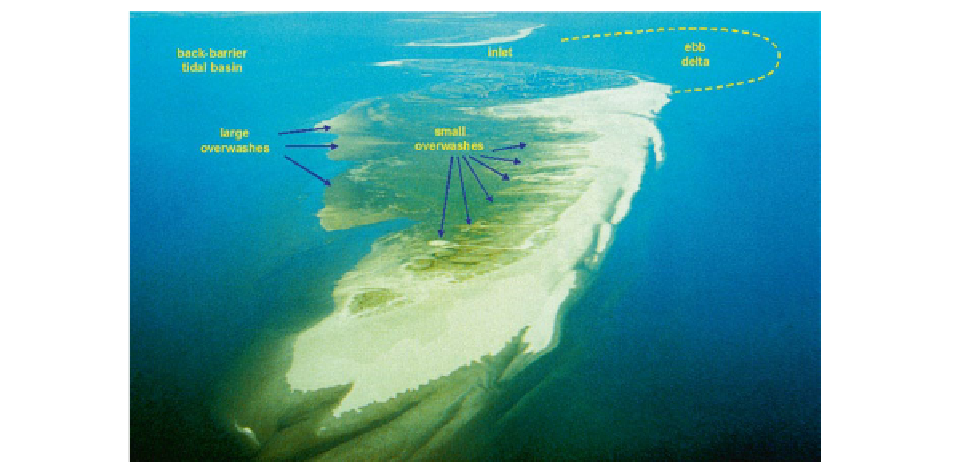Geology Reference
In-Depth Information
Fig. 10.5
Aerial view of a barrier island showing the location
of overwash fans (Spiekeroog island, East Frisian Wadden Sea).
Note the large fans that formed without obstruction of an eolian
dune belt (here pre-1962) in comparison to the much smaller
fans that formed after the establishment of the dune belt
(post-1962)
salt marshes (7 in inset of Fig.
10.4
) rapidly spread
eastward and overwash activity thus became channel-
ized through breaches in the dune belt, resulting in a
larger number of smaller fans terminating in the salt
marshes. Of particular interest here is the remarkably
regular spacing of the breaches, which suggest a
genetic link with resonant processes in the surf zone
(Flemming and Davis
1994
). The lobate overwash
splays on the upper tidal flats are not very thick and
hence difficult to identify on the ground. However,
besides clear evidence on aerial photographs (e.g.,
Fig.
10.5
), they can also be recognised by their grain-size
composition, which is essentially identical to that of
the adjacent beach sand (Flemming and Ziegler
1995
).
Within the back-barrier salt marsh, recent overwash
activity is highlighted by distinctly laminated, decime-
tre thick sand layers penetrated by the stems and roots
of salt marsh plants.
Toward the mainland shore follow the tidal flats
proper. These comprise sand flats (8), mixed flats
(9) and mud flats (10) (cf. Fig.
10.4
). While the margins
of sand flats slope more steeply toward the channels,
they are almost level some distance away at elevations
just below mean sea level. Along many channel margins,
sand flats display slightly elevated levees formed by
the interaction of tidal currents and wave action. Mixed
flats and mud flats, by contrast, gradually rise toward
the mean high water mark, convex profiles indicating
accretion, concave ones erosion (Kirby
2000
). As
illustrated in Fig.
10.3
, this sedimentary facies pro-
gression is hydrodynamically finely tuned, the energy
gradient being associated with a progressive reduction
in particle settling velocity.
10.3.2 Sedimentological Characteristics
In addition to indicators for emergence, the most strik-
ing feature of tidal flats is the pronounced shoreward
fining in grain size. In effect this means that grain-size
distributions gradually shift from coarser to finer mean
diameters (Bartholomä and Flemming
2007
), settling
velocity data being generally more sensitive than sieve
data because of the hydraulic sorting process (Flemming
2007
). This shift in mean grain size implies a gradual
change in the textural composition of the sediments. In
order to describe such sediments in a consistent way, a
variety of classification schemes have been devised,
ternary sand/silt/clay diagrams having been the most
commonly used ones (Shepard
1954
; Folk
1954
).
Because the determination of silt and clay content is
technically demanding, a simpler two-component
classification based on routinely determined mud con-
tent has recently been proposed by Flemming (
2000
).

